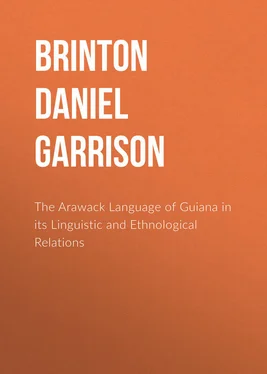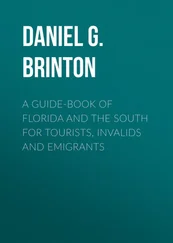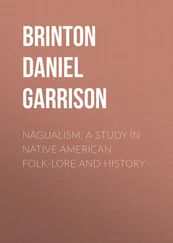Daniel Brinton - The Arawack Language of Guiana in its Linguistic and Ethnological Relations
Здесь есть возможность читать онлайн «Daniel Brinton - The Arawack Language of Guiana in its Linguistic and Ethnological Relations» — ознакомительный отрывок электронной книги совершенно бесплатно, а после прочтения отрывка купить полную версию. В некоторых случаях можно слушать аудио, скачать через торрент в формате fb2 и присутствует краткое содержание. ISBN: , Жанр: foreign_antique, foreign_prose, на английском языке. Описание произведения, (предисловие) а так же отзывы посетителей доступны на портале библиотеки ЛибКат.
- Название:The Arawack Language of Guiana in its Linguistic and Ethnological Relations
- Автор:
- Жанр:
- Год:неизвестен
- ISBN:http://www.gutenberg.org/ebooks/31273
- Рейтинг книги:5 / 5. Голосов: 1
-
Избранное:Добавить в избранное
- Отзывы:
-
Ваша оценка:
- 100
- 1
- 2
- 3
- 4
- 5
The Arawack Language of Guiana in its Linguistic and Ethnological Relations: краткое содержание, описание и аннотация
Предлагаем к чтению аннотацию, описание, краткое содержание или предисловие (зависит от того, что написал сам автор книги «The Arawack Language of Guiana in its Linguistic and Ethnological Relations»). Если вы не нашли необходимую информацию о книге — напишите в комментариях, мы постараемся отыскать её.
The Arawack Language of Guiana in its Linguistic and Ethnological Relations — читать онлайн ознакомительный отрывок
Ниже представлен текст книги, разбитый по страницам. Система сохранения места последней прочитанной страницы, позволяет с удобством читать онлайн бесплатно книгу «The Arawack Language of Guiana in its Linguistic and Ethnological Relations», без необходимости каждый раз заново искать на чём Вы остановились. Поставьте закладку, и сможете в любой момент перейти на страницу, на которой закончили чтение.
Интервал:
Закладка:
The Arawack Language of Guiana in its Linguistic and Ethnological Relations
THE ARAWACK LANGUAGE OF GUIANA IN ITS LINGUISTIC AND ETHNOLOGICAL RELATIONS.
BY D. G. BRINTON, M. D
The Arawacks are a tribe of Indians who at present dwell in British and Dutch Guiana, between the Corentyn and Pomeroon rivers. They call themselves simply lukkunu , men, and only their neighbors apply to them the contemptuous name aruac (corrupted by Europeans into Aroaquis, Arawaaks, Aroacos, Arawacks, etc.), meal-eaters, from their peaceful habit of gaining an important article of diet from the amylaceous pith of the Mauritia flexuosa palm, and the edible root of the cassava plant.
They number only about two thousand souls, and may seem to claim no more attention at the hands of the ethnologist than any other obscure Indian tribe. But if it can be shown that in former centuries they occupied the whole of the West Indian archipelago to within a few miles of the shore of the northern continent, then on the question whether their affiliations are with the tribes of the northern or southern mainland, depends our opinion of the course of migration of the primitive inhabitants of the western world. And if this is the tribe whose charming simplicity Columbus and Peter Martyr described in such poetic language, then the historian will acknowledge a desire to acquaint himself more closely with its past and its present. It is my intention to show that such was their former geographical position.
While in general features there is nothing to distinguish them from the red race elsewhere, they have strong national traits. Physically they are rather undersized, averaging not over five feet four inches in height, but strong-limbed, agile, and symmetrical. Their foreheads are low, their noses more allied to the Aryan types than usual with their race, and their skulls of that form defined by craniologists as orthognathic brachycephalic.
From the earliest times they have borne an excellent character. Hospitable, peace-loving, quick to accept the humbler arts of civilization and the simpler precepts of Christianity, they have ever offered a strong contrast to their neighbors, the cruel and warlike Caribs. They are not at all prone to steal, lie, or drink, and their worst faults are an addiction to blood-revenge, and a superstitious veneration for their priests.
They are divided into a number of families, over fifty in all, the genealogies of which are carefully kept in the female line, and the members of any one of which are forbidden to intermarry. In this singular institution they resemble many other native tribes.
LANGUAGE
The earliest specimen of their language under its present name is given by Johannes de Laet in his Novus Orbis, seu Descriptio Indiæ Occidentalis (Lugd. Bat. 1633). It was obtained in 1598. In 1738 the Moravian brethren founded several missionary stations in the country, but owing to various misfortunes, the last of their posts was given up in 1808. To them we owe the only valuable monuments of the language in existence.
Their first instructor was a mulatto boy, who assisted them in translating into the Arawack a life of Christ. I cannot learn that this is extant. Between 1748 and 1755 one of the missionaries, Theophilus Schumann, composed a dictionary, Deutsch-Arawakisches Wœrterbuch , and a grammar, Deutsch-Arawakische Sprachlehre , which have remained in manuscript in the library of the Moravian community at Paramaribo. Schumann died in 1760, and as he was the first to compose such works, the manuscript dictionary in the possession of Bishop Wullschlägel, erroneously referred by the late Professor von Martius to the first decade of the last century, is no doubt a copy of Schumann’s.
In 1807 another missionary, C. Quandt, published a Nachricht von Surinam , the appendix to which contains the best published grammatical notice of the tongue. The author resided in Surinam from 1769 to 1780.
Unquestionably, however, the most complete and accurate information in existence concerning both the verbal wealth and grammatical structure of the language, is contained in the manuscripts of the Rev. Theodore Schultz, now in the library of the American Philosophical Society. Mr. Shultz was a Moravian missionary, who was stationed among the Arawacks from 1790 to 1802, or thereabout. The manuscripts referred to are a dictionary and a grammar. The former is a quarto volume of 622 pages. The first 535 pages comprise an Arawack-German lexicon, the remainder is an appendix containing the names of trees, stars, birds, insects, grasses, minerals, places, and tribes. The grammar, Grammattikalische Sätze von der Aruwakkischen Sprache , is a 12mo volume of 173 pages, left in an unfinished condition. Besides these he left at his death a translation of the Acts of the Apostles, which was published in 1850 by the American Bible Society under the title Act Apostelnu . It is from these hitherto unused sources that I design to illustrate the character of the language, and study its former extension. 1 1 Since reading this article before the Society, Prof. S. S. Haldeman has shown me a copy of a work with the title: “ Die Geschichte von der Marterwoche, Auferstehung und Himmelfahrt unsers Herrn und Heilandes Jesu Christi. Uebersetzt in die Aruwackische Sprache und erklärend umschrieben. Philadelphia: Gedruckt bey Carl List, 1799 ,” 8vo. pages 213, then one blank leaf, then 40 pages of “Anmerkungen.” There is also a second title, in Arawack, and neither title page is included in the pagination. The Arawack title begins: “ Wadaijahun Wüüssada-goanti, Wappussida-goanti baddia Jesus Christus ,” etc. The remarks at the end are chiefly grammatical and critical, and contain many valuable hints to the student of the language. I have no doubt this book is the Life of Christ mentioned in the text. The name of the translator or editor is nowhere mentioned, but I have no doubt Mr. Schultz wrote the “Anmerkungen,” and read the proof, as not only are his grammatical signs and orthography adopted throughout, but also we know from other sources that he was in Philadelphia at that time.
PHONETICS
The Arawack is described as “the softest of all the Indian tongues.” 2 2 Brett, The Indian Tribes of Guiana , p. 117 (London, 1868).
It is rich in vowels, and free from gutturals. The enunciation is distinct and melodious. As it has been reduced to writing by Germans, the German value must be given to the letters employed, a fact which must always be borne in mind in comparing it with the neighboring tongues, nearly all of which are written with the Spanish orthography.
The Arawack alphabet has twenty letters: a, b, d, e, g, h, i, j, k, l, m, n, o, p, q, r, s, t, u, w.
Besides these, they have a semi-vowel written lr the sound of which in words of the masculine gender approaches l, in those of the neuter gender r. The o and u, and the t and d, are also frequently blended. The w has not the German but the soft English sound, as in we . The German dipthongs æ, œ, eu, ei, ü, are employed. The accents are the long ^, the acute `, and that indicating the emphasis ´. The latter is usually placed near the commencement of the word, and must be carefully observed.
NOUNS
Like most Indians, the Arawack rarely uses a noun in the abstract. An object in his mind is always connected with some person or thing, and this connection is signified by an affix, a suffix, or some change in the original form of the word. To this rule there are some exceptions, as bahü a house, siba a stone, hiäru a woman. Dáddikân hiäru , I see a woman. Such nouns are usually roots. Those derived from verbal roots are still more rarely employed independently.
Читать дальшеИнтервал:
Закладка:
Похожие книги на «The Arawack Language of Guiana in its Linguistic and Ethnological Relations»
Представляем Вашему вниманию похожие книги на «The Arawack Language of Guiana in its Linguistic and Ethnological Relations» списком для выбора. Мы отобрали схожую по названию и смыслу литературу в надежде предоставить читателям больше вариантов отыскать новые, интересные, ещё непрочитанные произведения.
Обсуждение, отзывы о книге «The Arawack Language of Guiana in its Linguistic and Ethnological Relations» и просто собственные мнения читателей. Оставьте ваши комментарии, напишите, что Вы думаете о произведении, его смысле или главных героях. Укажите что конкретно понравилось, а что нет, и почему Вы так считаете.












